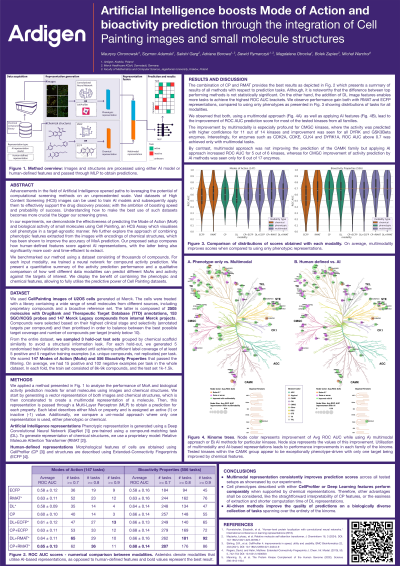Shaping the Future of Therapeutics
Poster Session B
(1099-B) Artificial Intelligence boosts Mode of Action and bioactivity prediction through the integration of Cell Painting images and small molecule structures
Wednesday, May 29, 2024
10:30 - 11:15 CEST
Location: Exhibit Hall


Maurycy Karol Chronowski (he/him/his)
Data Scientist
Ardigen
Kraków, Malopolskie, Poland
Poster Presenter(s)
Abstract: Advancements in the field of Artificial Intelligence opened paths to leveraging the potential of computational screening methods on an unprecedented scale. Vast datasets of High Content Screening (HCS) images can be used to train AI models and subsequently apply them to effectively support the drug discovery process; with the ambition of boosting speed and probability of success. Understanding how to make the best use of such datasets becomes more crucial the bigger our screening grows.
In our experiments, we demonstrate the effectiveness of predicting the Mode of Action (MoA) and biological activity of small molecules using Cell Painting, an HCS Assay which visualises cell phenotype in a target-agnostic manner. We further explore the approach of combining phenotypic features extracted from the images with encodings of chemical structures, which has been shown to improve the accuracy of MoA prediction. Our proposed setup compares how human-defined features score against AI representations, with the latter being also significantly more cost- and time-efficient to extract.
We benchmarked our method using a dataset consisting of thousands of compounds. For each input modality, we trained a neural network for compound activity prediction. We present a quantitative summary of the activity prediction performance and a qualitative comparison of how well different data modalities can predict different MoAs and activity against the targets of interest. We display the benefit of combining the phenotypic and chemical features, allowing to fully utilise the predictive power of Cell Painting datasets.
In our experiments, we demonstrate the effectiveness of predicting the Mode of Action (MoA) and biological activity of small molecules using Cell Painting, an HCS Assay which visualises cell phenotype in a target-agnostic manner. We further explore the approach of combining phenotypic features extracted from the images with encodings of chemical structures, which has been shown to improve the accuracy of MoA prediction. Our proposed setup compares how human-defined features score against AI representations, with the latter being also significantly more cost- and time-efficient to extract.
We benchmarked our method using a dataset consisting of thousands of compounds. For each input modality, we trained a neural network for compound activity prediction. We present a quantitative summary of the activity prediction performance and a qualitative comparison of how well different data modalities can predict different MoAs and activity against the targets of interest. We display the benefit of combining the phenotypic and chemical features, allowing to fully utilise the predictive power of Cell Painting datasets.
